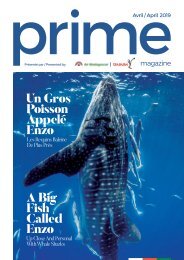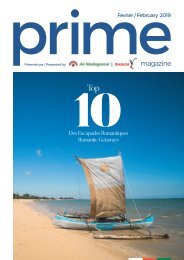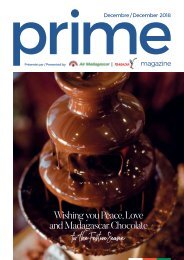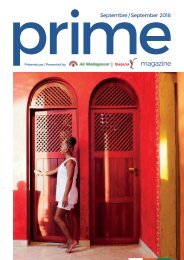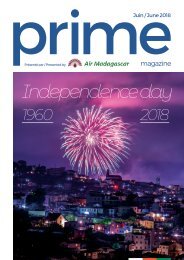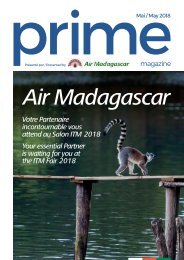PRIME MAG - AIR MAD - MARCH 2019 - SINGLE PAGES - LO-RES
Create successful ePaper yourself
Turn your PDF publications into a flip-book with our unique Google optimized e-Paper software.
CULTURE<br />
Beko<br />
Le Blues<br />
Malgache<br />
The<br />
Malagasy<br />
Blues<br />
Musique<br />
Découvrez une musique, le "beko" ou le blues<br />
malgache qui résonne dans le monde entier avec<br />
des racines profondes au sud de Madagascar.<br />
Music<br />
Discover a music, the "beko" or the Malagasy<br />
blues that resonerates around the world with<br />
roots in the deep south of Madagascar.<br />
Si quand on pense « grand sud malgache », on pense<br />
surtout, aridité et baobabs, il ne faut pas oublier<br />
la culture très riche du peuple Mikea. En musique,<br />
cette région constitue une immense source<br />
d’inspiration pour des artistes de tout horizon. On vient y<br />
trouver l’inspiration ou mieux, pour enrichir son répertoire,<br />
comme c’est le cas avec le beko. Plus qu’un style musical,<br />
le beko est un fondement de la société Antandroy.<br />
Le peuple du sud malgache est appelé les « Antandroy »,<br />
de nombreux artistes connu mondialement de la « world<br />
music » viennent de là. C’est le cas par exemple de Théo<br />
Rakotovao, du groupe Mikéa, lauréat du prix RFI musique<br />
en 2009 et qui a porté le beko dans le monde. C’est aussi<br />
le cas du trio vocal féminin Tiharea, originaire du grand sud<br />
de Madagascar mais se produisant en Europe et qui s’est<br />
aussi spécialisé ce style musical.<br />
Le beko plait par sa proximité avec le rythme du Blues.<br />
Il est toujours chanté a capella et généralement interprété<br />
par des hommes appelés « sahiry ». Cette musique fait<br />
résonner sa litanie répétitive et gutturale durant les veillées<br />
funèbres, où les mpibeko sont assis à même le sol pour<br />
accompagner l’esprit du défunt dans la marche vers l’Est,<br />
là où vivent les ancêtres. Traditionnellement, les jeunes<br />
Antandroy sont bercés par ce rythme dès le plus jeune âge.<br />
Les instruments peuvent être traditionnels: les percussions<br />
(le katsa fabriqué avec des boîtes de conserve), ou le<br />
langoro (tambour de guerre) et des djembés.<br />
For most of us, the ‘deep south' of Madagascar<br />
conjures up visions of arid landscape and baobabs.<br />
However, there is also the very rich culture of the<br />
Mikéa tribe. Musically, the region is a huge source<br />
of inspiration for artists from different regions, who come<br />
here in search of inspiration or, even more, to enrich their<br />
repertoire, which is the case of the beko. More than simply<br />
a musical style, beko forms the basis of the Antandroy<br />
Society.<br />
People from the south of Madagascar are referred to as<br />
Antandroy, and many renowned musicians producing<br />
‘world music’, come from the region. This is the case of<br />
Théo Rakotovao, playing with the band Mikéa, that won<br />
the 2009 RFI music award, making the beko style known<br />
the world over. The female singing trio Tiharea, specialised<br />
in this musical style, also comes from the south of<br />
Madagascar, but plays mainly in Europe.<br />
Beko became popular through its link with rhythm and<br />
blues. The musicians, usually men referred to as ‘sahiry’,<br />
always sing a capella. The singing, repetitive and guttural,<br />
is produced during wakes. The mpbeko sit on the bare floor<br />
and accompany the spirit of the dead person on its journey<br />
to the East, where the ancestors reside. Traditionally, the<br />
Antandroy children will be lulled by this rhythm from a<br />
very early age. Instruments played may be traditional:<br />
percussions (katsa, made out of tin cans), or the langoro<br />
(war drum), as well as the djembe.<br />
| 42 | Magazine online www.primemedia.international



